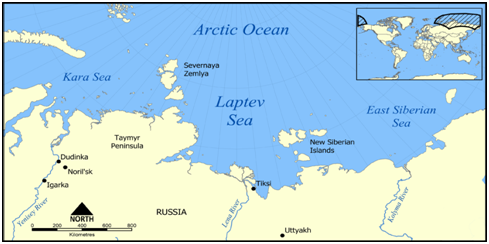

For the first time since records began, the Laptev Sea, the main nursery of Arctic sea ice in Siberia has yet to start freezing in late October.
Context
For the first time since records began, the Laptev Sea, the main nursery of Arctic sea ice in Siberia has yet to start freezing in late October.
The Laptev Sea
- The Laptev Sea, located on the northwest coast of Siberia, is the Arctic Ocean's main sea ice nursery.
- Strong offshore winds accelerate ice formation, then, the wind circulates the ice across the Arctic, supplying the ocean with floating ice packs.
- However, a heat wave in the Arctic this summer caused the ice to melt more rapidly than usual, leaving the open water exposed to the sun for longer.

What caused it?
- Warming: The delayed annual freeze in the Laptev Sea has been caused by freakishly protracted warmth in northern Russiaand the intrusion of Atlantic waters.
- Ocean warming & heat waves: Ocean temperatures in the area recently climbed to more than 5C above average, following a record breaking heatwaveand the unusually early decline of last winter’s sea ice.
- The trapped heat takes a long time to dissipate into the atmosphere, even at this time of the year when the sun creeps above the horizon for little more than an hour or two each day.
- Climate change: Climate changeis also pushing more balmy Atlantic currents into the Arctic and breaking up the usual stratification between warm deep waters and the cool surface. This also makes it difficult for ice to form.
What will be the impacts?
- Decline of the sea ice: Delayed freeze could amplify feedbacks that accelerate the decline of the sea ice.
- The Laptev Sea is known as the birthplace of ice, which forms along the coast there in early winter, then drifts westward carrying nutrients across the Arctic, before breaking up in the spring in the Fram Strait between Greenland and Svalbard.
- Thinner ice, more melting: If ice forms late in the Laptev, it will be thinner and thus more likely to melt before it reaches the Fram Strait.
- Reduced capacity to absorb CO2: This could mean fewer nutrients for Arctic plankton, which will then have a reduced capacity to draw down carbon dioxide from the atmosphere.
- Warmer water: More open sea also means more turbulence in the upper layer of the Arctic ocean, which draws up more warm water from the depths.
- More bad climatic situations: Arctic sea ice helps cool the whole planet by reflecting sunlight back into space. So its loss inevitably will affect the climate and weather beyond the Arctic.


